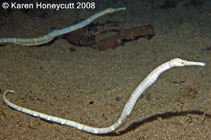| Family: |
Syngnathidae (Pipefishes and seahorses), subfamily: Syngnathinae |
| Max. size: |
40 cm TL (male/unsexed) |
| Environment: |
reef-associated; marine; depth range 1 - 42 m |
| Distribution: |
Indo-West Pacific: Red Sea and East Africa (Ref. 4281) to New Caledonia, north to southern Japan; Mariana Islands in Micronesia. |
| Diagnosis: |
Dorsal spines (total): 0-0; Dorsal soft rays (total): 24-32; Anal spines: 0-0; Anal soft rays: 4-4. Brownish in color, usually with small spots on trunk (Ref. 4281).
Description: Characterized by variable color, ranging from whitish or yellowish to blackish; usually 9 caudal rays in juvenile, vestigial or absent in adult; rings 21-24 + 55-63; discontinuous superior trunk and tail ridges; inferior trunk ridge ends at anal ring; confluent lateral trunk ridge with inferior tail ridge; length of snout 1.5-2.0 in head length; depth of snout 5.2-11.1 in snout length; head length 9.9-13.0 in SL (Ref. 90102). |
| Biology: |
Inhabits subtidal lagoon and seaward reefs, usually among algae or seagrasses (Ref. 9710). Most are seen on sand and mud areas, prone to currents; usually soft bottom to about 25 m (Ref. 48635). Ovoviviparous (Ref. 205). The male carries the eggs in a brood pouch which is found under the tail (Ref. 205). |
| IUCN Red List Status: |
Least Concern (LC); Date assessed: 27 August 2015 Ref. (130435)
|
| Threat to humans: |
harmless |
Source and more info: www.fishbase.org. For personal, classroom, and other internal use only. Not for publication.

